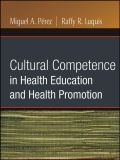
Cultural Competence in Health Education and Health Promotion is a groundbreaking book that examines the importance of ethnic and cultural factors for community health practice. Published with the American Association for Health Education, this resource describes best practice models for working with race, ethnicity, gender, and social issues. Useful for both undergraduate and graduate students in the field of health education and health promotion, as well as nursing and other allied health fields, the publication is essential reading for practitioners in the field of health education and promotion. INDICE: Foreword. The Editors. The Contributors. Acknowledgments. One: Changing U.S. Demographics: Challenges and Opportunities For Health Educators (Miguel A. Perez and Raffy R. Luquis). Learning Objectives. Introduction. Demographic Shifts. Demographics of Racial and Ethnic Groups. Conclusion. Points to Remember. Case Study. Key Terms. Two: Disparities In Health Among Racial And Ethnic Groups: Implications For Health Education (Suzanne Kotkin-Jaszi). Learning Objectives. Introduction. Health Disparities by Condition and Treatment. Health Disparities by Ethnic Group. Health Disparities and Health Education. Conclusion. Points to Remember. Case Study. Key Terms. Three: Cultural Competence and Health Education (Emogene Johnson Vaughn). Learning Objectives. Introduction. Defining Cultural Competence. Related and Discipline-Specific Cultural Competence Principles. Culturally Competent Practices in Diverse Settings. Issues, Concerns, and Strategies in Multicultural Training. The Counseling Role in Health Education. Conclusion. Points to Remember. Case Study. Key Terms. Four: Complementary and Alternative Medicine in Culturally Competent Health Education (Helda Pinzon-Perez). Learning Objectives. Introduction. Use of CAM. Definitions of Concepts in Nontraditional Healing . Modalities of CAM. The National Center for Complementary and Alternative Medicine. Application to Health Education. Conclusion. Points to Remember. Case Study. Key Terms. FIVE: A SPIRITUALLY GROUNDED AND CULTURALLY RESPONSIVE APPROACH TO HEALTH EDUCATION (Ann L. Swartz and Elizabeth J. Tisdell). Learning Objectives. Introduction. Defining Spirituality. Spirituality and Culture in Health Education,. Spirituality and Health: Rooted in Example. Educating for Health and Wholeness in Context. Conclusion. Points to Remember. Case Study. Key Terms. Six: Health Education Theoretical Models and Multicultural Populations (Raffy R. Luquis). Learning Objectives. Introduction. Models for Assessing Cultural Competence. Models for Developing Health Education Programs. Conclusion. Points to Remember. Case Study. Key Terms. Seven: Developing Culturally Appropriate Needs Assessments and Planning,Implementation, and Evaluation for Health Education and Promotion Programs (Nayamin Martinez-Cossio). Learning Objectives. Introduction. Identifying Cultural Factors Affecting Health Education. Conducting Needs Assessments in Culturally Diverse Groups. Planning and Implementing Culturally Appropriate Programs.Designing Culturally Appropriate Evaluations. Conclusion. Points to Remember.Case Studies. Key Terms. Eight: Communication and Cultural Competence (Matthew Adeyanju). Learning Objectives. Introduction. Communication and Culture. Communication and Cultural Competence. Historical Perspectives on Communication Across Cultures. Communicating Across Cultures About Health and Disease. Communication and Personal Health. Communication and Community Health. Communicationand Marketing Techniques. Communication Patterns and Language Barriers. Conclusion. Points to Remember. Case Study. Key Terms. Nine: Toward A Culturally Competent Health Education Workforce (Eva I. Doyle). Learning Objectives. Introduction. Cultural Competence and Professional Preparation Programs. Cultural Competence and the Work Setting. Conclusion. Points to Remember. Case Study. KeyTerms. Ten: Strategies, Practices, and Models For Delivering Culturally Competent Health Education Programs (Miguel A. Perez). Learning Objectives. Introduction. Health Indicators. Cultural Diversity and Health Education. Cultural Diversity and Health Education Professional Programs. CLAS Standards. Four Areasof Cultural Competence. Recommendations for Working with Diverse Groups. Conclusion. Points to Remember. Case Study. Key Terms. Eleven: Aging and Health Education: Partners For Learning (Carolina Aguilera, William H. Dailey Jr., and Miguel A. Perez). Learning Objectives. Introduction. Demographic Characteristics of Older Americans. Issues Facing the Older Adult Population. Health Literacy Among Older Adults. Cultural Competence with Older Adults. Healthy Aging and Health Education. Conclusion. Points to Remember. Case Study. Key Terms. TWELVE: CULTURE AND SEXUAL ORIENTATION (Kay Woodiel and Kate Brindle). Learning Objectives. Introduction. The LGBT Culture. Health Issues of the LGBT Community. Health Issues Common to All LGBT Groups. Health Issues of LGBT Youths . Health Issues of Lesbian and Bisexual Women. Health Issues of Gay and Bisexual Men. Health Issues of Transgender Communities. Health Issues of LGBT Racially andEthnically Diverse Communities. Increasing Cultural Sensitivity Toward the LGBT Community. Conclusion . Points to Remember. Case Study. Key Terms. Thirteen: Cultural Competence and Health Education: Challenges and Opportunities for The Twenty-First Century (Raffy R. Luquis And Miguel A. Perez). Learning Objectives. Introduction. Understanding the Need for Cultural and Linguistic Competence. Achieving Cultural Competence. Acquiring Linguistic Competence. Supporting Cultural and Linguistic Competence in Health Education. Strategies to Incorporate Cultural and Linguistic Competence into Health Education. Standards for Cultural and Linguistic Competence in Health Education. Conclusion. Points to Remember. Key Terms. Appendix A: Position Statement of the American Association for Health Education. Appendix B: Web Resources for Understanding Health Disparities. Appendix C: Known Health Disparities Among Racial and Ethnic Groups.Appendix D: Web Resources for Working with the Elderly. Index.
- ISBN: 978-0-7879-8636-0
- Editorial: Jossey Bass
- Encuadernacion: Rústica
- Páginas: 304
- Fecha Publicación: 11/09/2008
- Nº Volúmenes: 1
- Idioma: Inglés
